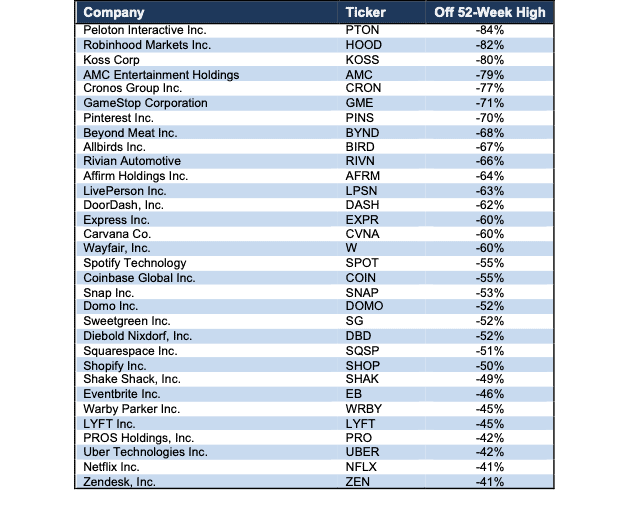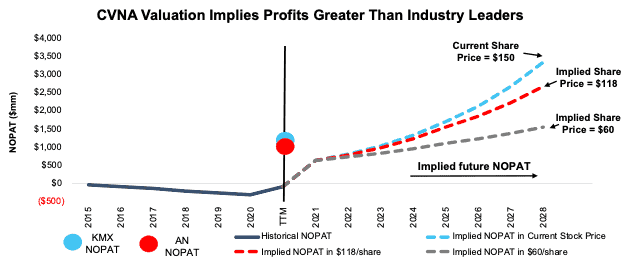We published an update on CVNA on April 25, 2022. A copy of the associated update report is here.
We counsel investors not to try and catch falling knives – stocks that have seen steep declines but still have further to fall. As the market rotates away from high-flying growth names to more stable cash generators, investors need reliable fundamental research, more than ever, to protect their portfolios from falling knives.
We continue to post an exceptional hit rate on spotting overvalued stocks. Currently, 62 out of our 65 Danger Zone stock picks are down from their 52-week highs by more than the S&P 500. Figure 1 lists the open Danger Zone picks that are down at least 40% from their 52-week highs. Our Focus List Stocks: Short Model Portfolio, the best-of-the-best of our Danger Zone picks, outperformed the S&P 500 as a short portfolio by 36% in 2021 with 29 out of our 31 picks outperforming the index.
This report highlights one particularly dangerous falling knife: Carvana (CVNA: $150/share). We highlight four other falling knives in other reports published today: Allbirds (BIRD: $12/share) here, Sweetgreen (SG: $31/share) here, Wayfair (W: $140/share) here, and Shake Shack (SHAK: $64/share) here. Each of these stocks have dropped at least 40% from all-time highs, yet still carry at least 40% additional downside risk.
Figure 1: Danger Zone Picks Down >40% From 52-Week High – Performance through 2/4/22
Sources: New Constructs, LLC
Falling Knife: Carvana Co (CVNA): Down 61% from 52-Wk High & 60%+ Downside Remaining
We put Carvana (CVNA) in the Danger Zone in August 2020 and the stock has outperformed the S&P 500 as a short by 58% since then. The drop from its 52-week high has been even larger, and the stock could fall another 60%. We detail Carvana’s lack of profitability, cash burn, and significant competitive disadvantages in our report here.
Valuation Implies Carvana Generates More Sales than Two Largest Used Car Dealers Combined
We use our reverse discounted cash flow (DCF) model to analyze the future cash flow expectations baked into Carvana’s current valuation. We find that, despite negative margins in a year that saw record used-car prices and larger, profitable competition, Carvana is priced as if it will grow revenues to levels higher than the combined revenues of CarMax (KMX) and AutoNation (AN).
To justify its current price of $150/share, Carvana must:
- immediately improve its NOPAT margin to 5%, which is equal to its peer group’s[1] average TTM margin (compared to Carvana’s -1% margin) and
- grow revenue by 36% compounded annually (6x projected industry growth over the next decade) for the next eight years.
In this scenario, Carvana’s revenue in 2028 would reach $66 billion, which is 122% of the combined TTM revenue of CarMax (KMX) and AutoNation (AN), the two largest used car dealers by TTM revenue.
This scenario implies the firm would sell ~2.5 million retail and wholesale vehicles in 2028[2] versus just over the half million sold over the last twelve months. Such high sales would be 1.5x the vehicles sold over the TTM by the largest U.S. used car retailer, CarMax (KMX). In a mature market, which used cars surely are, that much growth requires taking significant market share away from leading competitors, which seems unlikely while also improving margins at rates implied by the expectations in Carvana’s stock price.
Companies that grow revenue by anywhere near 20%+ compounded annually for such a long period are unbelievably rare, which make the expectations in Carvana’s share price even more unrealistic.
21% Downside Even If Carvana Reaches 2 Million Vehicle Goal
Carvana’s economic book value, or no growth value, is negative $31/share, which illustrates the overly optimistic expectations in its stock price.
Even if we assume Carvana meets its stated goal of selling 2 million vehicles per year, shares hold 21% downside from the current price.
If we assume Carvana’s:
- NOPAT margin improves to 5% (equal to peer group average TTM margin) and
- revenue grows by 33% compounded annually over the next eight years, then
the stock is worth just $118/share today – a 21% downside to the current price. In this scenario, the firm grows revenue to $54 billion in 2028 and, assuming Carvana generates ~$27 thousand per vehicle sold (using same assumptions listed in prior scenario), the firm would sell 2 million vehicles in 2028.
This scenario also implies Carvana grows NOPAT from -$82 million over the TTM to $2.6 billion (double CarMax’s TTM NOPAT) in 2028, which is more than 2x CarMax’s TTM NOPAT.
Should Carvana fail to grow over 5x as fast as the used car industry, the downside is even larger, as we show below.
60% Downside Even If Carvana Grows 4x Industry Rate
We review an additional DCF scenario to highlight the downside risk even if Carvana’s revenue grows four times as fast as the used car industry.
If we assume Carvana’s:
- NOPAT margin improves to 5% and
- revenue grows by 24% compounded annually over the next eight years, then
the stock is worth just $60/share today – a 60% downside to the current price. This scenario implies Carvana grows NOPAT from -$82 million over the TTM to $1.5 billion in 2028, which is 120% of CarMax’s TTM NOPAT.
Figure 2 compares Carvana’s implied future NOPAT in these three scenarios to its historical NOPAT. We also include the TTM NOPAT for CarMax and AutoNation for reference
Figure 2: Carvana’s Historical and Implied NOPAT: DCF Valuation Scenarios
Sources: New Constructs, LLC and company filings.
Each of the above scenarios also assumes Carvana grows revenue, NOPAT, and FCF without increasing working capital or fixed assets. This assumption is highly unlikely but allows us to create best-case scenarios that demonstrate the expectations embedded in the current valuation. For reference, Carvana’s invested capital grew 77% compounded annually from 2015 through 2020 and TTM invested capital is 93% higher than the prior TTM period. If we assume Carvana’s invested capital increases at a similar rate in DCF scenarios 2 and 3 above, the downside risk is even larger.
Fundamental Research Provides Clarity in Frothy Markets
2022 has quickly shown investors that fundamentals matter and stocks don’t only go up. With a better grasp on fundamentals, investors have a better sense of what and when to buy and sell – and – know how much risk they take when they own a stock at certain levels. Without reliable fundamental research, investors have no reliable way of knowing whether a stock is expensive or cheap.
As shown above, disciplined, reliable fundamental research shows that even after plummeting, Allbirds, Sweetgreen, Carvana, Wayfair, and Shake Shack still hold significant downside.
This article originally published on February 7, 2022.
Disclosure: David Trainer, Kyle Guske II, and Matt Shuler receive no compensation to write about any specific stock, style, or theme.
Follow us on Twitter, Facebook, LinkedIn, and StockTwits for real-time alerts on all our research.
[1] Peer group includes America’s Car-Mart (CRMT), Asbury Automotive Group (ABG), AutoNation (AN), CarMax (KMX), Cars.com (CARS), Group 1 Automotive (GPI), KAR Auction Services (KAR), Lithia Motors (LAD), Penske Automotive Group (PAG), Sonic Automotive (SAH), and TrueCar, Inc. (TRUE).
[2] Calculated by taking the implied revenue divided by the implied revenue per vehicle. Over the TTM, Carvana generated a total of $10.9 billion in revenue and sold 529 thousand combined retail and wholesale vehicles, which equates to ~$20.6 thousand in revenue per unit sold. Assuming inflation of 3.5% per year, revenue per unit sold in 2028 would be ~$27.1 thousand.


